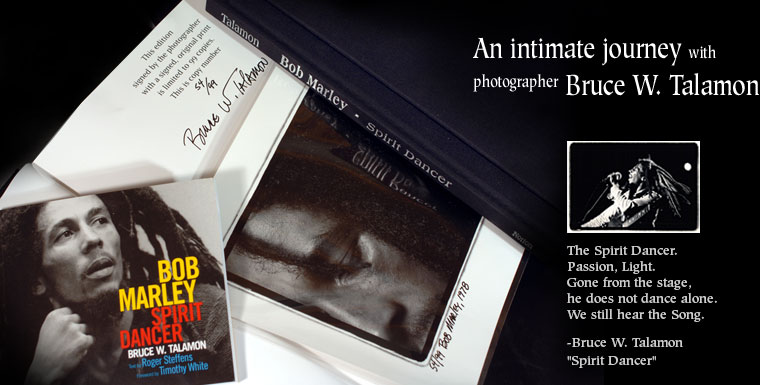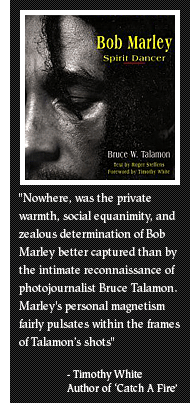 |
|
Photographer Bruce W. Talamon captured these images of Bob Marley between 1978 and 1980 when he was granted unprecedented access to Bob Marley; on stage, backstage, center stage and unstaged. The resulting images are one of the most uniquely comprehensive collections of Bob Marley images available. The thousands of images were finally edited in 1994 to create the book "Bob Marley - Spirit Dancer."
My interest was more in the preparation that ultimately became the finished presentation. Sound checks and backstage jams are infinitely more interesting to me. The dynamics of the working relationship between band members has always fascinated me. Also, I wanted to leave a visual record that went beyond the public image. I will not discount the theory that there was a bit of Divine Guidance going on there, back in 1978. I remember remarking to my lab man that this was one assignment where it seemed that I was very lucky. I couldn't miss. Content, exposure, focus, angle... I look to page 80, backstage, warming up. To this day, I wonder what inspired me to place the camera directly on the floor, angled up and focusing through the top. I could have shot that photo standing up; it would have been just okay. I have said in every interview that this shoot was different. For the portrait session at the L'Ermitage Hotel, I brought a macro lens; I never bring a close-up lens to a shoot. That shot on page 2 became the original cover for Spirit Dancer.
My first picture of Bob was taken at the Starlite Amphitheater in Burbank, California. I was ushered into a smoke filled room. Bob, spliff dangling from his mouth, was standing in the middle of the room surrounded by band members running down the song order. I took one shot and sat back to listen and wait. Those days of unfettered access are now history. I shot formal portrait sessions, backstage jams, rehearsals, sound checks and performances. From the start, Bob was comfortable with the way I worked. He never asked me to put my camera down. The last time I saw Bob was in Paris; Charles de Gaulle Airport, January, 1980. We shook hands and he was gone. NPR's "Day To Day" Program (February 4, 2005) Bruce talks about his experiences touring with Marley with NPR's Alex Chadwick.
It has been more than two decades since Bob Marley's untimely death in 1981 but he is still a powerful presence worldwide. His music remains at the top of the reggae charts, while his memory is indelibly etched in the minds of millions of his admirers. In the last three years of his life, he met photographer Bruce W. Talamon, with whom he felt comfortable enough to grant unprecedented access, both on stage and off. The result of this collaboration is "Bob Marley - Spirit Dancer," published in 1994. "Nowhere," writes Timothy White, author of "Catch A Fire: The Life Of Bob Marley" was the private warmth, social equanimity, and zealous determination of the man better captured than by the intimate reconnaissance of photojournalist Bruce Talamon... Marley's personal magnetism fairly pulsates within the frames of Talamon's shots.... A number of fine photojournalists did portraiture of Marley during the course of his career, but Talamon's work eclipses the other's simply because Bruce's non-intrusive style conveyed the ordinary way Marley actually lived his life in the peak years of his international acceptance. The book, "Bob Marley - Spirit Dancer" contains 90 black and white duotone photographs, printed in Italy, by Arnoldo Mondadori Editore, Verona, Italy. Roger Steffens' text creates a moving and informative essay from highlights of Bob's life, to intimate background obtained through hours of personal interviews and correspondence with Bob, his family and confidants which, with Timothy White's introduction sets the proper mood and framework to view the photographs. The only suggestion that these three contributors might add would be that the photographs are best viewed with Bob's music playing... LOUD!!!
KIRKUS REVIEWS
PEOPLE MAGAZINE
ENTERTAINMENT WEEKLY |
